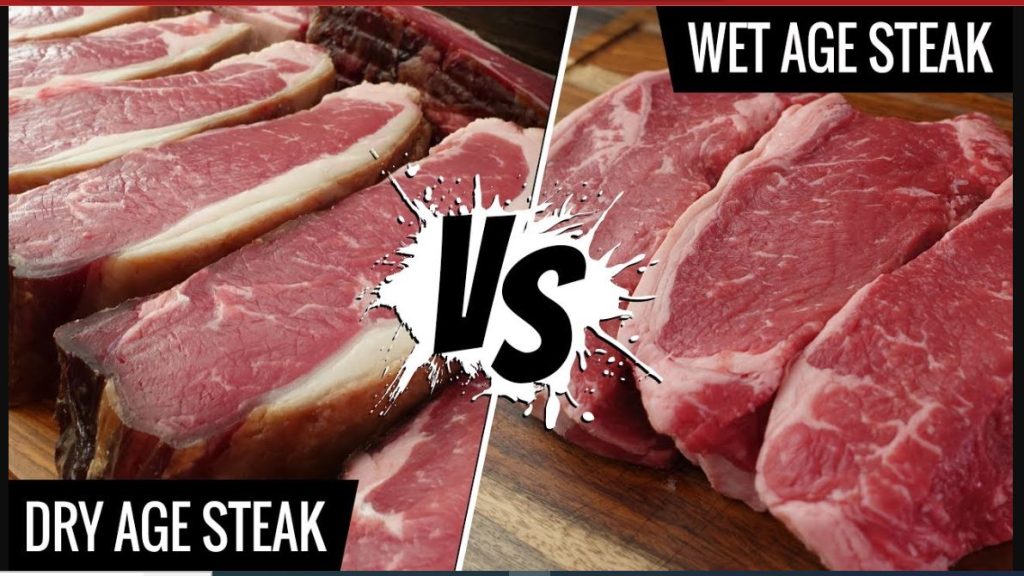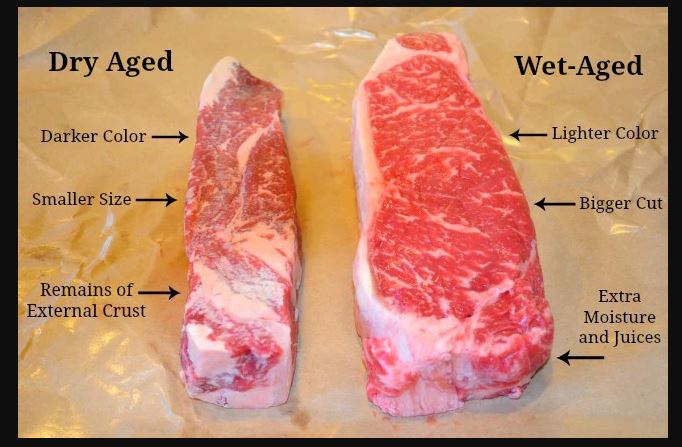Non-veg food is the favorite diet of many people. Many people have different preferences for meat. Some like juicy meat, while others like dry meat. Most people like juicy meat, But juicy meat has two categories, and you have to select one, i.e., dry or wet. The difference in preferences does not make us hyper.

If you want to get a good steak for your money, it will help you understand what matters and what marketing gibberish is. When looking for high-end steak, you will be damned by the term dry-aged. But what it means, and what are the fundamental differences between wet Aging vs dry Aging? Let’s find out.
What Is Wet Aging vs Dry Aging
The fundamental difference between wet-aged and dry-aged beef is that they have different preservation methods. Wet Aging is a modern method that includes meat aging by meat juices themselves in a vacuum.
As you know, wet Aging is the present age method, so in this method, small pieces of meat are placed in the polythene bag. In comparison, wet Aging is an old method. In this method, the whole animal or a large piece of meat is hung at 32 degrees Celsius.
The pieces of meat are packed as they are slaughtered. The vacuum helps to prevent the direct contact of beef with the air. Hence, the juice of meat makes it age itself, and thus it becomes juicy. It maintains its quality and increases its shelf life.

Dry Aging is an old method for storing meat. The process includes slaughtering animals and then hanging the large pieces or whole animals in a closed room. These pieces are placed on the porous shelves at 32 degrees Celsius. You need to monitor the dry Aging.
What Is Wet Aging?
Wet Aging is a method for preserving meat. It is a modern technique in which a vacuum is used to keep the meat. The procedure requires cutting small pieces of meat and placing them in polythene bags.
These polythene bags prevent the meat from getting spoiled as it prevents the oxidation of meat. The technique is also helpful for storing meat on a large scale. It would help if you had a refrigerator for wet Aging as the temperature for wet Aging is 2.2 degrees Celsius.
The wet-aging beef process is much slower and cheaper than dry Aging. It reduces the meat’s rancidity, and the meat’s shelf life increases. Keeping meat without air contact for a long time makes it possible to store it for a long period of time.
It is a reliable method, and meat wastage is very low. The texture of meat remains the same, but the taste of wet-aged meat is not trustable. The meat gets dry as the water evaporates on heating. The method is used in industries widely for storing and transporting meat.
What Is Dry Aging?
Dry Aging is an old method of storing meat. In this process, the large pieces of slaughtered animal or whole in a closed room or kept on the porose shelves. You have to ensure the room is closed at 32 degrees Celsius.
Now, let the Aging of meat slow. The method needs your attention because everything should be correct. In this process, the meat is cut into pieces, and meat juices are present in the room along with air.
There is also a natural way of Aging included. In Dry Aging, the natural taste and texture of the meat remain the same. The fat will degrade itself, the bonds break, and thus the Aging of meat takes place. That’s why the process requires monitoring.
The dry-aged meat is rich in flavor and juicy. The only downside of this method is the shelf life of dry-aged meat is less than that of wet-aged meat. Besides, the process is expensive as rotten meat cannot be sold or eaten.
Dry Aging Vs Wet Aging: Features Comparison
Which one is better, wet-aging or dry-aging? It depends upon your budget, your cut of meat, and your taste.
Quality
The dry-Aging process is more expensive than wet Aging. Besides, it takes supervision, space, and time and yields low. So, many people are going through wet Aging, and they use transit time from storing to butchering. The dry-aged meat offered by different companies is of high quality because, regardless of its time-consuming, it gives high-quality products.
Flavor
When it comes to flavor among wet Aging and dry Aging, it depends on your preference. Some people like the meatier flavor of dry-aged meat. However, meat dry-aged for a long time is only selected by some. At the same time, wet-aged meat gives an intense and sour taste compared to dry-aged meat. It is because the meat cannot take in air as the vacuum is sealed.
Moisture
All meat cuts are unsuitable for dry Aging because moisture loss occurs in this process. For example, skirts, tenders, and flat iron are meat cuts that will dry out too much. Lean cuts and low fat such as mignon are best for wet-aging. The subprimal amount on bone and large muscles is best for dry Aging as bones and layers of fat prevent moisture loss.
Wet-Aged Vs Dry-Aged Comparison Chart
The price and flavor are the most significant differences between dry-aged and wet-aged meat. Some factors should be considered before selecting them, such as juiciness, tenderness, fat content, flavor, and price. These factors are briefly described in the table below.
| Features | Dry Aging | Wet Aging |
| Price | $120-$280 | $70-$110 |
| Texture | More tender | Less tender |
| Flavor | Slightly sour, Nutty | Fresh, Metallic |
| Aging Time | 4-6 Weeks | 7-28 Days |
| Process | In the controlled environment | In polythene bags in the refrigerator at low-temperature |
| Type of Cuts | Bone-in strip steaks, porterhouse, richly marbled bone-in ribeyes | Filets, t-bones, sirloins, ribeyes, lean boneless strip steaks |
Wet Aged Vs Dry aged Ribeye
Ribeye is a perfectly flavorful, tender, juicy, and marbled piece of meat available without or with bone. It is challenging to cook bone-in ribeye as it takes much more time to cook meat next to the bone. Thus, you will get unevenly cooked food by paying extra time.
Even though the bone gives texture, flavor, and moisture to the meat, it is effortless to cook boneless ribeye. Dry-aged and wet-aged meat have their texture and taste depending upon the aging time. Dry-aged ribeye has many characteristics like a slightly sour and nutty taste, moist texture, and tenderness which intensifies with increasing aged time.
While on the other hand, wet-aged ribeye has a tender texture and fresh flavor and is slightly metallic. They will convert into a delicious, juicy, and tender steak. But, the dry-aged ribeye gives more texture and taste because its aging time is longer than wet-aging.
Is Dry Aging Really Better?
Dry-aged meat is strong in flavor and more tender than wet-aged meat. To avoid spoiling, the meat is aged in air-flow, humidity, and temperature-controlled environments. While in dry Aging, meat loses its moisture, and as a result, lean meat shrinks in fat.
The outer layer of meat becomes dry, forming a crust. However, the meat is tender and moist inside. The bacteria on the surface of meat give a nutty, specific, and rich flavor that intensifies if the heart is dry-aged longer. When the dry-aging completes, the external surface of the meat gets trimmed so that the dry and molded meat gets out.
On average, the meat can lose 30% of its weight in the trimming and losing moisture. The process requires a controlled environment, equipment, and time, but the process is worth it as the dry-aged meat gives a good taste. Hence, dry-aged beef is better than wet-aged meat, but it all depends on you.
Frequently Asked Questions
Final Words
The difference between wet and dry aging is the choice of meat and the way to age. Dry-aged meat is more desirable than wet-aged meat for both flavor and price. While dry-aged steaks will cost a bit more, there are excellent reasons for spending that extra dime. It is a few cents per ounce of steak, but it is worth it for many reasons.






